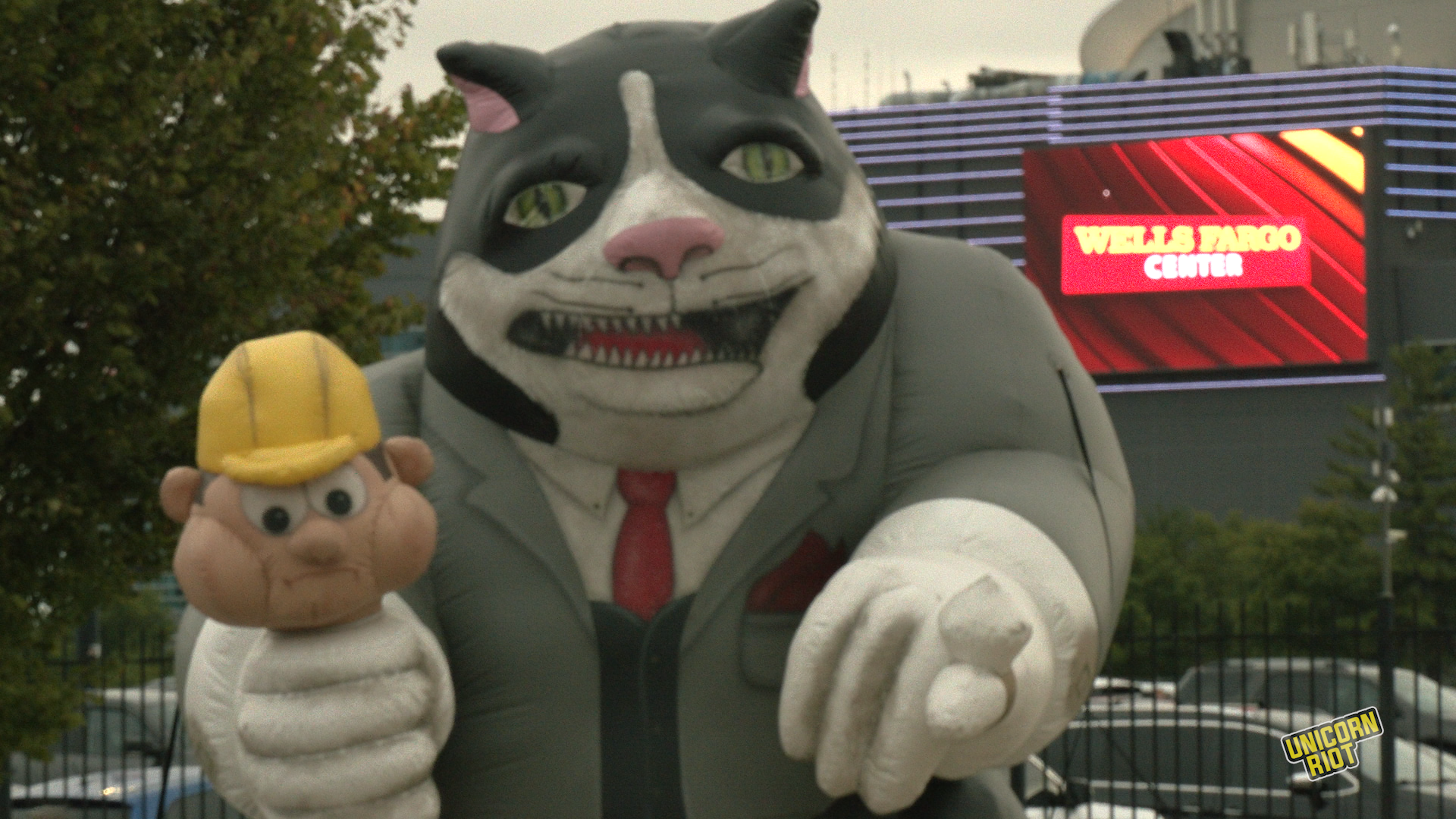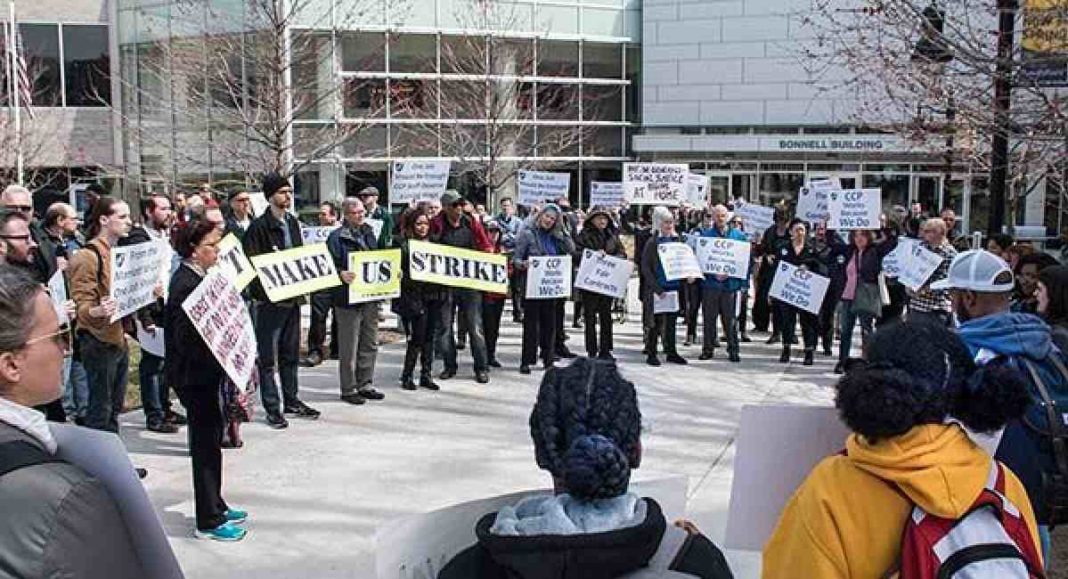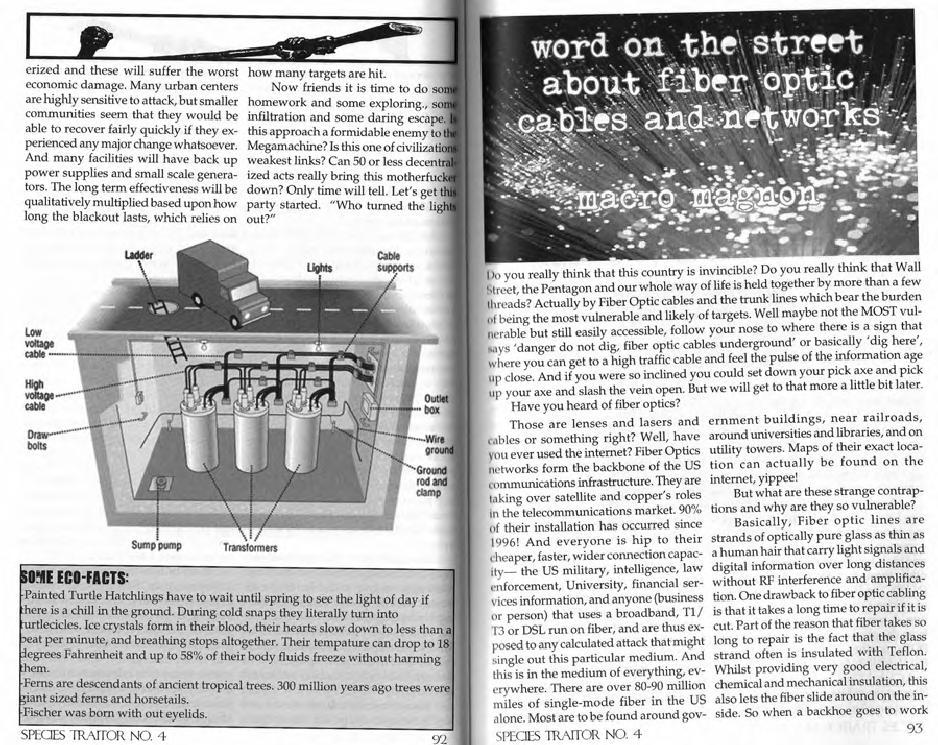Anarchists in Philadelphia conducted an interview with a teacher at a community college following a successful contract fight.
In April, the union of teachers and staff at the Community College of Philadelphia won an important victory: a contract fighting off many of the years-long attacks from the administration.
Administrators had been pushing aggressively for higher workloads for teachers while at the same time attacking healthcare for all employees at the college. The Faculty and Staff Federation (AFT Local 2026) mobilized and pushed back, ultimately preparing for a strike. In response, the administration threatened to cut health insurance for all employees -an attack on the most vulnerable workers at the college and a transparent attempt to divide and conquer.
But the impending strike brought admins back to the table, and a new contract was signed. In the compromise that followed, the union won a workload reduction and the administration backed off a number of threatened healthcare cost increases, as well as agreeing to a pay increase for staff. But the union victory was partial. For example, Yusefa Smith notes in the union’s press release:
We didn’t win on class-size. I’m still teaching 36 students per class … At Montco and Bucks [other Philadelphia area community colleges], it’s 27-28 students per class. But we did win some workload reductions, which is a victory for our students. But we will keep fighting on class size.
The following is an interview with a union activist member of the full-time faculty at CCP. They wished to remain anonymous. We asked what lessons other campus workers can learn from the union struggle at CCP.
Can you summarize some of the important background regarding the recent CCP union struggle?
Sure thing. Before we get started, though, I should say upfront that I’m not an official union (or college) spokesperson, and the views I’m expressing here are solely my own.
Our union represents about 1,200 workers at Community College of Philadelphia and is composed of three bargaining units: the full-time faculty unit, the part-time and visiting lecturer faculty unit, and the classified employees unit, which includes many of the non-faculty workers at the college.
The collective bargaining agreement at CCP has historically been a pretty good one thanks to the work of our union going back to the 1970s. In recent years, the upper administration of the college and the board of trustees have sought to chip away at it. The most recent contract negotiations, which began around 2016, represented a continuation of that trend.
The college administration began negotiations by proposing that we accept several deeply concessionary proposals which would have negatively affected educational quality and made it more difficult to attract and retain a diverse faculty, among other things. The administration’s demands were wide-ranging and would have affected workload, joint governance, pay, and benefits. The admin basically wanted us to give up significant past victories in all those areas and more. The admin’s opening proposals would have meant some of the lowest paid workers at the college would have remained woefully underpaid. They also would have seriously undermined shared governance at the college, to the detriment of our students and everyone who works at the college. We were able to fend off many of these proposed changes but unfortunately not all of them.
In the last few years, teacher strikes have been kicking off, with an important rank-and-file power making itself felt within them. How do you see faculty/staff struggles at colleges fitting into that bigger picture of teacher strikes? What can we learn? Why is it important to struggle for worker rights on campuses?
This is a great and complex question, and I’m not sure I know the full answer. But there are some things I see in common when I look at labor action by education workers, whether they are early childhood educators, K-12, or higher ed workers.
First, I think it’s important to recognize that “education workers” means more than just teachers. At CCP our union represents faculty members, but it also represents the non-faculty workers who help the college run. This is one of the things I like best about our union.
Second, I think the struggles of education workers are inextricably tied up with the struggles of our students. We want schools that are good places to work and to teach, and our students deserve schools that are good places to learn.
Third, I think victories for education unions are important for the economy as a whole. Each one helps shape the labor market we all work in, and the labor market our students work in or will work in.
On a related note, I think the struggle we’re seeing between education workers and those who would try to control us is related to the question of the purpose of our schools. Are our schools going to be places where students learn the bare minimum of the basic skills they need to serve corporations and governments? Or are our schools going to be places where students are able to really develop themselves as whole people, meaningfully reflect on history and the present, and begin to develop solutions to the problems that are important to them? If it’s the latter (and I think the future health of our society depends on it being the latter), that’s going to take resources, and I think, unfortunately, it’s fallen to education workers, students, and community allies to have to fight for those resources.
I think the root cause of a lot of the strikes and other discontent I’m seeing among education workers is the result of government underinvestment in public education as a result of neoliberal austerity and the related rise of the notion that “schools should be run like businesses.” This is particularly salient and pernicious in institutions that are supposed to serve historically underserved populations.
I think the response is for education workers, students, parents, and community members to demand full and fair funding of all of our systems of public education. I would like to see education workers’ unions at the forefront of that.
What strategies did you see the administration using against the workers/union in recent months/years? What were some of the more effective ways campus workers responded?
Even people who had been at the college for a long time said this was the most inflexible and unreasonable they’ve seen a CCP administration be in negotiations. The administration’s tactics ranged from the sort of typical corporate anti-union crap you’d expect, to the sometimes bizarrely petty, to the really despicable threat they made to cut off the health insurance of everyone who went on strike.
The threat against the health insurance of anyone who went on strike I found especially odious. The administration made it against people who, in some cases, were making less than $15 an hour and who qualify for public assistance for food. We have union members who are on chemotherapy or who have family members on chemotherapy. We have members with high-risk pregnancies. We have members whose children have disabilities that require ongoing treatment. For the administration to threaten to suspend these people’s health insurance in retaliation for striking I found to be really disgraceful. I’m not sure what the college administration’s plan is now to try to come back from that and credibly claim to be leaders of the college, other than in an authoritarian way.
Our union’s response to this threat was to help our members understand how they could remain insured through COBRA or by purchasing their own health insurance. But I think this also underscores the importance to future labor struggle of universal government-provided health insurance.
For the years these negotiations were going on the administration spent I can only imagine how much of the college’s money on an outside law firm to represent and advise them. They also did strange things like order our union posters taken down from college bulletin boards. While we couldn’t outspend the administration on lawyers, since, you know, we were spending our own dues money instead of taxpayer and student dollars, the union does have a negotiations and strike fund and a lawyer of our own. As far as the posters being taken down: Well, there are more of us than there are of them, so we just put them back up.
The administration did other things, too. My understanding is that there was an agreement to keep the exact content of negotiation sessions mostly private, but the administration seemed to not fully abide by that. They’d cherry pick what they thought were the best parts of their proposals and put them out in public and email them to all the students. They’d use this to try to further their narrative that the union was being unreasonable. I think a good response to this for next time would be to have open bargaining.
Another thing the administration tried to do was to drive wedges between our bargaining units. Like I mentioned, two of our bargaining units represent faculty members, while the third one represents non-faculty workers at the college. I think the administration tried to take advantage of this in several ways. One thing they did was focus very intensely on proposals they had for increased workload for faculty. Faculty fought back against this, and I think the administration then tried to say, or at least imply, to the non-faculty workers something along the lines of, “See, the faculty are holding up your contract by fighting us over workload.” I can’t speak for everyone, but I think this sort of “divide and rule” tactic was pretty transparent, and in the end we stuck together and signed three contracts together, as we traditionally have. I think maintaining and increasing solidarity, communication, and camaraderie between and within the three bargaining units is going to be important for our union going forward. I think an important part of that is going to be committing to making our union a more actively anti-racist union, as there are different racial demographics in the different bargaining units.
What worked best in your struggle? What do you think were the most effective strategies and tactics?
I think the foundation of the most successful elements of our campaign were organizing conversations. These are conversations where union members volunteer to talk to other union members about what they’re thinking and feeling and what they’d like to see happen with our union. I think these are important for so many reasons. They build trust and relationships, and they allow union leadership to understand what members want in an in-depth way and make decisions accordingly.
Another important part of our effort was making it clear how what we were fighting for would be beneficial for students and the larger community. The Bargaining for the Common Good Network does a great job of describing this method of campaigning, and we used a lot from their framework in organizing our own efforts.
We received some political support from some members of state and local government, but when it came down to it, it was our demonstrated willingness to strike if needed that caused real change at the bargaining table.
What role did students play in the strike? How crucial are students as a support system for education workers struggling on a college campus?
From my perspective, students played a huge role.
First, on a personal note, I was deeply touched by how supportive my students were when I told them we might go on strike. I was worried they might see a potential strike as a betrayal on the part of their teachers, but almost none of my students seemed to think about it that way. Obviously, we all wanted to avoid a strike if we could, but my students were really clear that they’d be in support of me and the union if it came to a strike. I can’t fully describe how much that meant to me, just on a personal level.
Secondly, the possibility of a strike meant there was a lot of discussion on campus about strikes and unions. Some of this was between union members and students. Some of it was students talking to other students. Some of this was in class. Some of it was outside of class. But, all in all, I’d say the possibility of a strike led to a greater awareness among the students about unions and their power and importance. I remember one of my students saying something in one of our class discussions like, “Wait, so you can just say ‘no’ to what your bosses want to do? We gotta get a union at my work.”
Some students became actively involved in support of our contract campaign, contacting local politicians, the college president, and the college board of trustees. Some showed up at our demonstrations. Some talked about running for student government and trying to address the same issues with the college that the union wants addressed regarding things like funding, resources for students, and class sizes. It was really inspiring and touching for me to see our students become aware and active around these issues like many of them did. I think this may have been one of the best aspects of the contract campaign for me.
What main lessons do you think other education workers struggling in Philly and beyond could learn from what’s been happening at CCP recently?
So much happened. I think I am still processing and learning from everything that happened. But right now, these are the things that stand out as lessons I learned:
The importance of ongoing one-on-one organizing conversations between members as an organizing strategy that builds solidarity, camaradiere, and communication.
The importance of using a Bargaining For The Common Good framework where the union makes clear how what the union is fighting for will benefit the greater community. In our case, this was things like fighting for full funding for the college, smaller class sizes, more resources for students, and a more diverse faculty at the college.
Start organizing and preparing to strike early. Like years early. Our current contract ends in three years, and we have already begun our campaign for the next one.
Don’t underestimate how much work it is. I didn’t formally count, but I am sure our contract campaign required literally thousands of work hours.
At least in our situation, the negotiating at the bargaining table seemed to be more about power than debate. It didn’t seem to really matter whether we had reason, logic, evidence, and well-crafted arguments for our proposals. It seemed to come down to whether we could demonstrate enough power to force the other side to have to change their position. As an academic observing negotiations at an academic institution, I found this particularly disappointing, but I guess here we are in late capitalism.
Political allies are nice, but it’s the threat of a strike that is the source of your power.
I hope this is all helpful information.




